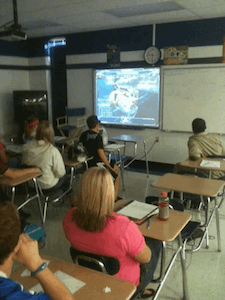Hooks, TX--Hooks Independent School District of Hooks, Texas has become one of the first to introduce 3D learning into its curriculum, using systems from XPAND 3D.
- "It wasn’t so much about being one of the first to try 3D in the classroom; it was about being able to provide students with a better learning environment in today’s world,” said Ronnie Thompson, Superintendent of Schools for Hooks ISD.
- “I had the opportunity to view the XPAND 3D technology first-hand at a presentation given by Texas Instruments last spring. From that experience and after doing some research, I was convinced that students would benefit from being able to view abstract concepts in 3D,” Thompson said. “When I came to Hooks ISD in April, I mentioned the technology to our tchnology director Keith Minter, who was instrumental in figuring out what components we needed, including our active 3D projection system and the XPAND Universal 3D Glasses.”
- Thompson noted that math and science are particularly good subjects for 3D learning. “They usually have more abstract concepts than other subject areas, and scores on state assessments are usually lower in these two subject areas, so we thought that being able to view math and science subject matter in 3D would be most helpful,” he said.
- “The benefits of active 3D technology are readily apparent to me,” said David Lee, science coach at Hooks ISD. “Without a doubt, the students stay more focused on their lessons. Since we’ve implemented 3D into our curriculum, it is apparent that our students are more attentive and on task. When we talk to them after the lessons, they have a better understanding of the material presented.”
- “3D is also helpful for subjects other than math and science,” Thompson said. “Many students we serve come from lower socioeconomic backgrounds and usually don’t have the means to travel to see museums and other areas of the world. 3D can bring a new dimension, literally, to the classroom for social studies, English and career and technology programs.”
- “We think that 3D technology is one of the most exciting developments for education in years,” said Ami Dror, chief strategy officer for XPAND 3D. “Studies have shown that students who receive 3D learning can achieve higher test scores compared to presenting the material in 2D or from books. 3D makes learning more involving and exciting.”
- Since implementing the XPAND 3D systems, the technology has already paid off. “The students and the science faculty have responded in a positive manner,” said Lee. “The realistic representation 3D provides compared to traditional presentation methods has clearly resulted in students having better recollection of the material.”










